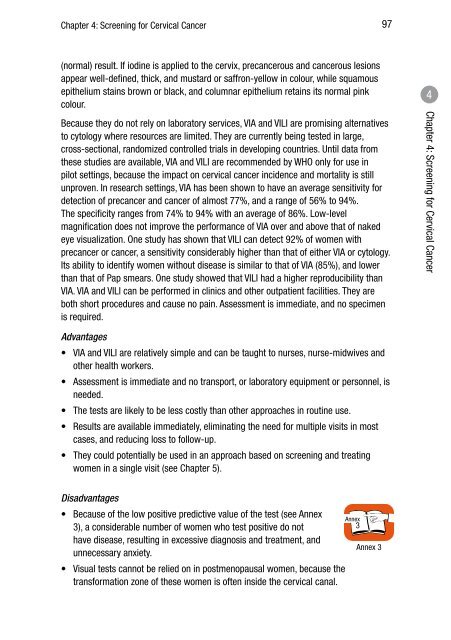CHAPTER 4: SCREENING FOR CERVICAL CANCER
CHAPTER 4: SCREENING FOR CERVICAL CANCER
CHAPTER 4: SCREENING FOR CERVICAL CANCER
You also want an ePaper? Increase the reach of your titles
YUMPU automatically turns print PDFs into web optimized ePapers that Google loves.
Chapter 4: Screening for Cervical Cancer 97(normal) result. If iodine is applied to the cervix, precancerous and cancerous lesionsappear well-defined, thick, and mustard or saffron-yellow in colour, while squamousepithelium stains brown or black, and columnar epithelium retains its normal pinkcolour.Because they do not rely on laboratory services, VIA and VILI are promising alternativesto cytology where resources are limited. They are currently being tested in large,cross-sectional, randomized controlled trials in developing countries. Until data fromthese studies are available, VIA and VILI are recommended by WHO only for use inpilot settings, because the impact on cervical cancer incidence and mortality is stillunproven. In research settings, VIA has been shown to have an average sensitivity fordetection of precancer and cancer of almost 77%, and a range of 56% to 94%.The specificity ranges from 74% to 94% with an average of 86%. Low-levelmagnification does not improve the performance of VIA over and above that of nakedeye visualization. One study has shown that VILI can detect 92% of women withprecancer or cancer, a sensitivity considerably higher than that of either VIA or cytology.Its ability to identify women without disease is similar to that of VIA (85%), and lowerthan that of Pap smears. One study showed that VILI had a higher reproducibility thanVIA. VIA and VILI can be performed in clinics and other outpatient facilities. They areboth short procedures and cause no pain. Assessment is immediate, and no specimenis required.4Chapter 4: Screening for Cervical CancerAdvantages• VIA and VILI are relatively simple and can be taught to nurses, nurse-midwives andother health workers.• Assessment is immediate and no transport, or laboratory equipment or personnel, isneeded.• The tests are likely to be less costly than other approaches in routine use.• Results are available immediately, eliminating the need for multiple visits in mostcases, and reducing loss to follow-up.• They could potentially be used in an approach based on screening and treatingwomen in a single visit (see Chapter 5).Disadvantages• Because of the low positive predictive value of the test (see Annex3), a considerable number of women who test positive do nothave disease, resulting in excessive diagnosis and treatment, andunnecessary anxiety.• Visual tests cannot be relied on in postmenopausal women, because thetransformation zone of these women is often inside the cervical canal.Annex3Annex 3
















